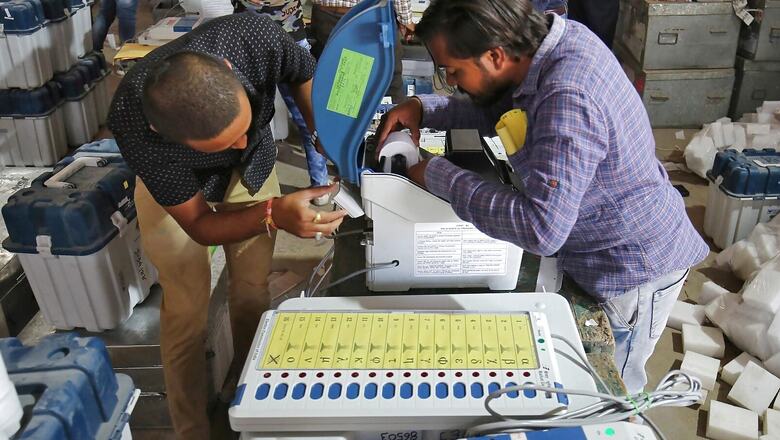
views
The assembly polls that started from western Uttar Pradesh are now all set to enter the heartland of Purvanchal or eastern UP. As chief minister Yogi Adityanath’s own backyard of Gorakhpur and the region nearby goes to the polls on March 3 in phase 6, a big focus will also be on the Bahujan Samaj Party (BSP). A lot will depend on how strong the BSP can be in the region that has traditionally been defined by Dalit and backward caste politics. It is also the belt where BSP’s social engineering still continues to hold the ground despite repeated electoral setbacks in the past two assembly elections.
It is in this belt of eastern UP, comprising 57 constituencies across 10 districts of Balrampur, Siddharthnagar, Maharajganj, Kushinagar, Basti, Sant Kabir Nagar, Ambedkar Nagar, Gorakhpur, Deoria and Ballia that the BJP will hope the Bahujan Samaj Party remains a strong contestant. Only a strong BSP can ensure a triangular fight in an election that has so far been seen as a bipolar one between the BJP and the Samajwadi Party. A triangular fight can mean a split of the anti-BJP votes.
It is probably this political calculation that was the reason behind union home minister Amit Shah’s recent comment endorsing the BSP. Speaking to News18 in an exclusive interview, Shah had said that the BSP has not lost its relevance in UP politics and that it continues to have a firm hold on its vote base. He also said that not just the Dalits but also the Muslims had voted for the BSP.
And even before the larger political rationale behind Shah’s comment could be analysed, BSP chief Mayawati herself had come forward to not just second Shah’s observations but add that not just the Dalits and the Muslims but also people from the most backward classes and other sections of society were also supporting her party.
In the heartland of eastern UP, the BSP can remerge as the big ‘make or break’ factor. The 2017 election result shows that the party is still a force in the region. Out of the total 19 seats that the BSP won, 5 were from this region. In 2012, of the 80 seats the party had bagged, nine were in the constituencies that will see voting in phase 6. Even in its downward graph of victories, the BSP was runner-up on a significant number of seats in 2017.
In the previous assembly polls, the BJP had won 47 out of the 61 seats at stake. The SP had won just two and the BSP five. Mayawati’s party was also the principal opponent to the BJP in the districts of Balrampur, Siddharth Nagar, Basti, Sant Kabeer Nagar and Gorakhpur. In the 2012 elections, the SP had won 31 seats in this phase, the BJP eight, falling one short of the BSP. No doubt, BSP politics can be a factor to watch out for in this phase.
UP CM AS CANDIDATE—THE YOGI FACTOR
The election in phase 6 on March 3 has also become interesting with UP CM Yogi Adityanath’s own candidature from the Gorakhpur Urban seat. From 1998 to 2017, the year he became the chief minister, Yogi had been the Member of Parliament from Gorakhpur. Out of the nine assembly constituencies in the district, eight were won by the BJP in 2017 and one, Chillupar, by the BSP. In 2012, the BJP had won three, BSP four and SP just one.
The popularity and the clout of the famous Gorakhnath Math of which Yogi Adityanath is also the head priest has consistently influenced the elections in the region. With Yogi now as the CM, the influence is expected to further play a role.
In the neighbouring districts of Deoria, Kushinagar and Maharajganj where the BJP won 15 out of the 19 assembly constituencies in 2017, the party will hope that the ‘Yogi as CM’ factor with its strong Hindutva manifestation and good governance argument will again help it in the contest. Yogi’s candidature does the much-needed messaging of his continued role in state politics.
‘DOUBLE-ENGINE GOVT’ PHENOMENON
In this region of eastern Uttar Pradesh that over decades had been marked by poverty and slow pace of development, the BJP is also banking on its “double-engine government” led development initiative. The party claims that eastern UP has seen a big vikas (development) push under the leadership of Prime Minister Narendra Modi and chief minister Yogi Adityanath.
From the successful completion of the 361km-long Purvanchal expressway to the inauguration of the AIIMS and the fertiliser plant in Gorakhpur, the BJP has pitched them as its commitment towards the growth of eastern UP. Prime Minister Modi had repeatedly reminded the people of the necessity of the “double-engine government” phenomenon. The party will hope that it will have a strong resonance with the voters.
SP BANKS ON ITS NEW ‘MANDAL’ SYNERGY
For the Samajwadi Party, the electoral outcome will largely depend on the success of it’s new Mandal politics. The party’s efforts to expand its base beyond the traditional Yadav-OBC combination will see a big test in this phase. SP chief Akhilesh Yadav will be banking big on the likes of Swami Prasad Maurya, Ram Achal Rajbhar and Lalji Verma to deliver on the new caste synthesis.
Swami Prasad Maurya, a prominent non-Yadav OBC leader, had left the BJP and resigned from the Yogi cabinet in January this year. He is now contesting on an SP ticket from Fazilnagar in Kushinagar district. Can he ensure the larger shifting of the MBC vote towards the SP? That remains to be seen.
In Ambedkar Nagar, adjoining the district of Ayodhya, the SP is banking on the two-long term associates of BSP chief Mayawati. Both Ram Achal and Lalji Verma, once pillars of the BSP’s OBC politics are now contesting on SP tickets from the Akbarpur and Katehari constituencies, respectively.
In 2017, despite a saffron tsunami, the BSP won three out of five assembly seats in the district. The remaining two were bagged by the BJP. In 2012, the SP won all five. The party will surely hope its social engineering delivers results here.
The party will also count on its larger OBC politics to counter the Nishad factor in the Gorakhpur region. The Nishad Party, with its strongest base in the district of Gorakhpur and nearby, is firmly with the BJP. Nishads, or the fishermen community, constitute a sizable segment of the OBC population in this phase.
Read all the Latest Politics News and Breaking News here




















Comments
0 comment